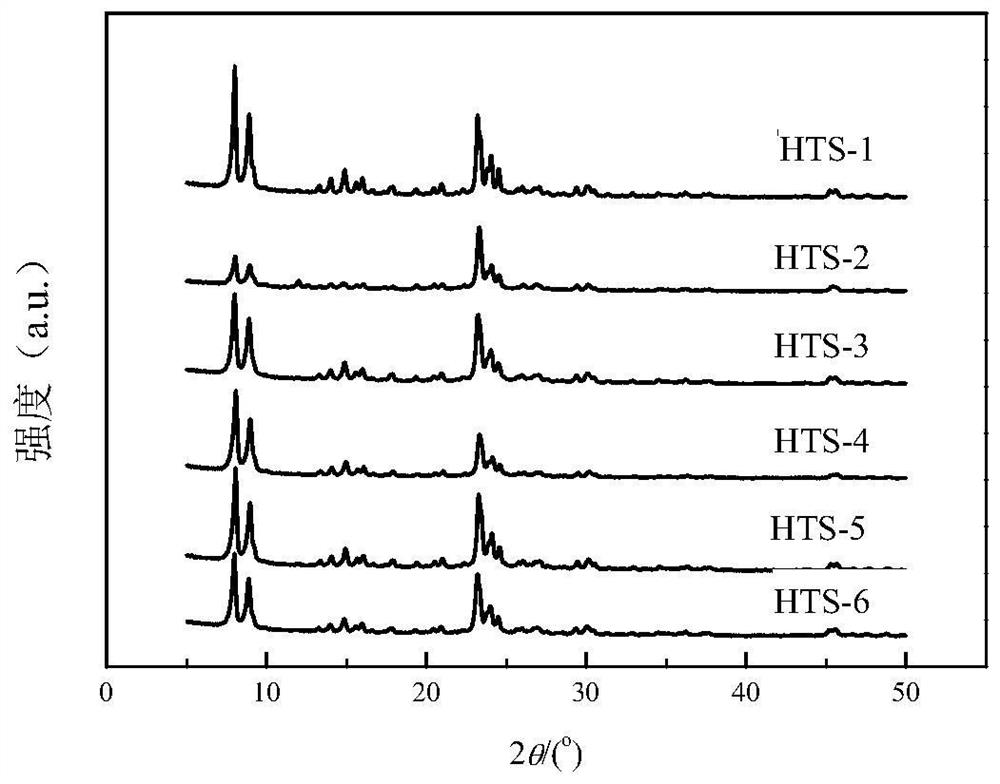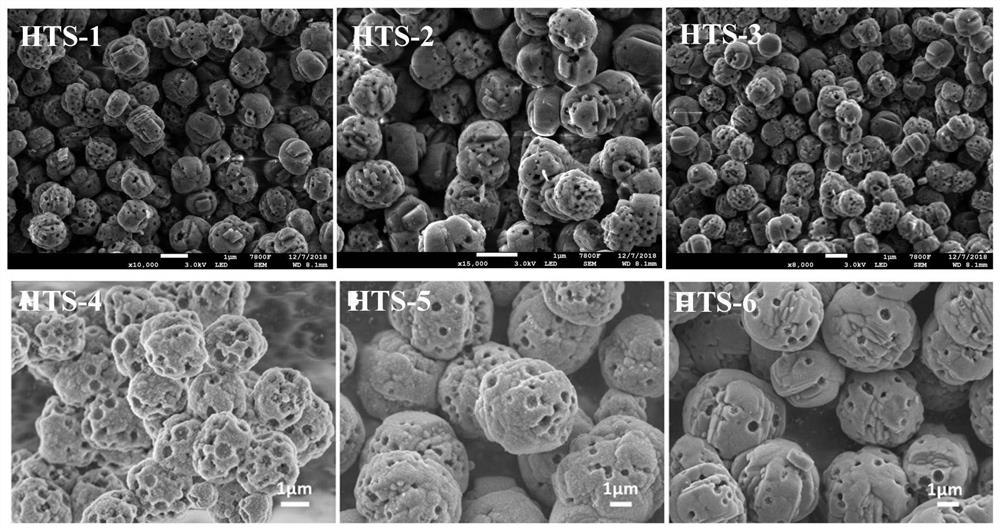TS-1 molecular sieve with macroporous-microporous composite pore channel structure as well as preparation method and application of TS-1 molecular sieve
A TS-1, composite channel technology, used in molecular sieve compounds, molecular sieve catalysts, molecular sieve characteristic silicates, etc., can solve the problem that the diffusion efficiency of guest molecules in the molecular sieve channels cannot be effectively improved, the improvement of molecular sieve diffusion performance is limited, and the multi-level pores cannot be effectively improved. The problem of high production cost of molecular sieve, to achieve the effect of good heat and mass transfer ability, excellent catalytic performance, simple and feasible method
- Summary
- Abstract
- Description
- Claims
- Application Information
AI Technical Summary
Problems solved by technology
Method used
Image
Examples
Embodiment 1
[0054] Example 1 Preparation of Amorphous Mesoporous Titanium Oxide / Silicon Ball MTS-I~MTS-Ⅴ
[0055] Preparation of sample MTS-I:
[0056] Under the condition of stirring at 50°C, dissolve 0.20 g of cetyltrimethylammonium bromide (structure directing agent I) in 60 mL of deionized water and ethanol solution, then add ammonia water to the solution to adjust the pH value of the solution, and stir Then add 1.0 g of ethyl orthosilicate, 0.05 g of tetrabutyl titanate after 30 min, and continue stirring for 2 h. After the product was filtered, washed, washed with water, and dried, the structure directing agent I was removed by calcination, wherein the calcination temperature was 550° C., and the calcination time was 6 hours to obtain a white powder. That is, amorphous titania / silica spheres, labeled MTS-I.
[0057] Preparation of samples MTS-II, MTS-III, MTS-IV, MTS-Ⅴ:
[0058] According to the conditions listed in Table 1 below, samples MTS-II and MTS-III were prepared respecti...
Embodiment 2
[0064] Embodiment 2: the preparation of sample HTS-1~HTS-8
[0065] First, the structure directing agent II was added into deionized water, stirred and dissolved to obtain a mixed solution. A certain amount of the above solution was taken to impregnate the amorphous titanium dioxide / silicon spheres prepared in Example 1, and dried at room temperature for a period of time to obtain a solid mixture. The above solid mixture was transferred to the upper plate of the stainless steel autoclave, and water was added to the bottom of the autoclave. Seal the stainless steel reaction kettle, put it in an oven, and crystallize at 100-200°C for 12-100h. Cool rapidly after the reaction, separate the solid product, wash with deionized water, dry at 110°C in air atmosphere and calcined at 550°C for 6 hours to obtain nano TS-1 molecular sieve. Samples are labeled HTS-1 to HTS-8. Table 2 shows the raw material types and proportions, crystallization temperature and crystallization time of the...
Embodiment 3
[0071] Embodiment 3: 1-hexene epoxidation reaction evaluation
[0072] In the experiment, the TS-1 sample was synthesized by the traditional hydrothermal method, and the ratio of the synthetic gel was 1SiO 2 :0.25TPAOH:0.02TiO 2 :35H 2 O. Concrete gel preparation steps: first, add tetrapropylammonium hydroxide (TPAOH) to deionized water at room temperature and stir; after it is fully dissolved, slowly add a certain amount of ethyl orthosilicate and butyl titanate; After continuing to stir at room temperature for 24h, the raw material was transferred to a stainless steel synthesis kettle and crystallized at 150°C for 24h. The resulting solid product was centrifuged, washed, dried overnight at 110°C, and finally calcined at 550°C for 6 hours to remove the organic template, which was named conv-TS-1.
[0073] The prepared conv-TS-1 and the nano-TS-1 molecular sieve prepared in Example 2 were evaluated for the epoxidation reaction of 1-hexene. The specific steps of reaction e...
PUM
| Property | Measurement | Unit |
|---|---|---|
| pore size | aaaaa | aaaaa |
| particle size | aaaaa | aaaaa |
| size | aaaaa | aaaaa |
Abstract
Description
Claims
Application Information
 Login to View More
Login to View More - R&D
- Intellectual Property
- Life Sciences
- Materials
- Tech Scout
- Unparalleled Data Quality
- Higher Quality Content
- 60% Fewer Hallucinations
Browse by: Latest US Patents, China's latest patents, Technical Efficacy Thesaurus, Application Domain, Technology Topic, Popular Technical Reports.
© 2025 PatSnap. All rights reserved.Legal|Privacy policy|Modern Slavery Act Transparency Statement|Sitemap|About US| Contact US: help@patsnap.com



